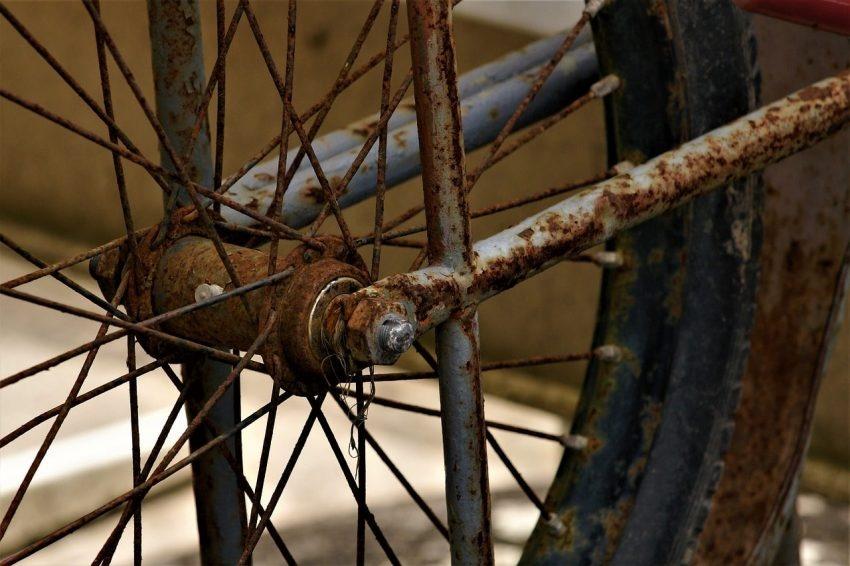Introduction
Rust can destroy your bike and render it unusable. It is surprisingly easy for your bicycle frame and rims to develop rust patches if they are not well looked after. Although you can return your bike to its former glory if it has already become rusty, prevention is by far the best cure.
Rust is simply a reaction between water and oxygen on iron that creates hydrated iron oxide, or as we call it, rust. Once formed, it has a nasty tendency to spread. This oxidation leads to corrosion of the iron’s integrity and will ruin your bicycle frame and rims if left untreated.

Before stressing too much about whether your frame and rims are susceptible to rust, do bear in mind that this oxidization process only affects iron. Therefore if your bicycle frame and rims are aluminum, titanium, or carbon fiber, you do not have to worry about them rusting.
Basically, any material other than steel or iron will not rust. That does not mean that each metal is not susceptible to some form of corrosion if left unmaintained and unloved. So you can still apply these practices below to ensure the longevity of your bicycle frame and rims.
Prevention is the best cure
Although there are ways to fight off any existing rust that has developed on your bike, by far, the best cure is to prevent it from having the chance to appear in the first place.
As with a lot of bicycle maintenance advice, the frequency you will need to clean/dry and maintain your bike depends on how often you use it, what type of conditions you ride in, and where you store your bike overnight/when not in use.
Here are some general pointers that everyone should use to help prevent rust from developing on bicycle frames and rims.
Clean your bike
Although dirt does not cause rust, leaving your bike unloved after a particularly muddy or rainy ride will give rust a chance to take hold. You do not need to deep clean your bike after every ride.
However, you should use your judgment and assess how much your bicycle frame and rims were exposed to dirt, soil, mud, and, most importantly, water.
 You should aim to give your bike a deep clean every 20 rides or so. This will prevent any dirt and muck from working its way into any of the bearings or components. The simplest way to clean your bike is with a pressure washer.
You should aim to give your bike a deep clean every 20 rides or so. This will prevent any dirt and muck from working its way into any of the bearings or components. The simplest way to clean your bike is with a pressure washer.
That is the lazy man’s way of getting your bike back to its previous glory in no time at all. However, if you do not have a pressure washer, a bucket of slightly soapy water and a sponge/brush will do the trick but will take you a little longer.
Obviously, once you have finished cleaning off all the muck, you need to dry down your bike. Pay attention to this step of the cleaning process as it is the residual water that can wreak havoc and lead to rust development.
Top tip: if you have an air compressor kicking about in your garage, these are perfect for getting rid of any lingering moisture in hard to reach places.

Once you have dried off the bike the best you can, then you get a rust-proofing lubricant (there are loads of different ones available). They are aerosol, so make sure you are outside in a well-ventilated area.
These wonder sprays are great as they dispel any water that has worked its way into the hard to reach places. After leaving it for some time, you just need to give your bike one final wipe down, and you are ready to store it away until your next ride.
Top tip: if you have rim brakes, avoid putting any lubricant directly on the rims. If it does get on there, try to rub it off. If left, it can seriously impact your brakes’ ability to bring you to a stop.
Keep your bike dry
It is impossible to keep your bike dry while cycling in the rain. Fortunately, bicycle frames and rims are waterproof. So you do not need to worry about them getting wet. However, it is the persistent presence of water that will kick start the oxidization process and lead to rust development.
After a ride in the rain, you should take the time to quickly dry down your bike before storing it. It may be the last thing you want to do after a hard and wet ride, but it will go a long way to preserving your bicycle frame, rims, and components.
All cyclists have lives off the bike, so if you do not get around to dry it off after every ride, do not worry about it too much. However, do not make it a habit of storing your bicycle away while it is still wet.
Cover your bike if left outside overnight
Some of us have no space to keep our bikes in our house, apartment, or garage. If you have no option other than storing your bike outside, you should take extra precautions to help prevent rust on your bicycle frame and rims. Invest in a heavy-duty waterproof bicycle cover.

This will stop the worst of the elements causing damage to the bike frame. Even if you have an old bit of tarpaulin lying around, that will do the job. Just make sure that it is tied down securely.
Remember, the aim is to keep your bike as dry as possible. You cannot prevent the moisture in the air, but you can at least cover your bike from the rain’s worst effects.
Final Thoughts
Keeping your bicycle frame and rims clean, dry, and well maintained will prevent rust development. Also, by regularly cleaning your bike, you will be able to spot any rust before it becomes a huge problem.
Although rust and corrosion will hamper the integrity of your bike frame and rims, it can be easily treated. You can use several home remedies, including baking soda and vinegar and a fair bit of elbow grease.
However, by far, the best solution is to prevent rust from being able to develop in the first place.
I’ve spent way more time in the bike trade than anyone should reasonably want to. In that time I’ve wanted to make cycling jargon and marketing easier to cut through to help people get the bike of their dreams.
When I’m not writing about bikes, I can be seen out bikepacking on single speed bikes or teaching kids how to ride.


